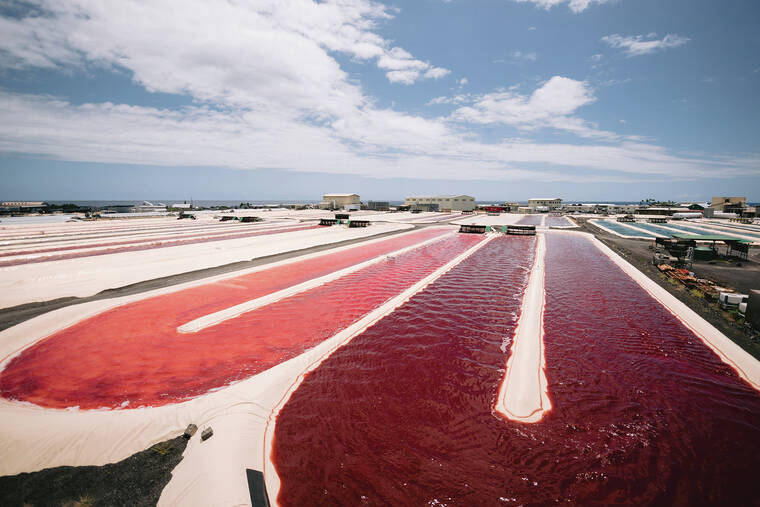Aquaculture sales in Hawaii reached a record-high $79.6 million in 2021, surpassing 2020 figures by nearly 20%.
The U.S. Department of Agriculture in its annual report released Sept. 8 said $39.3 million — or 49% — of aquaculture sales statewide in 2021 came from producers falling in the “other” category, which comprises various aquaculture products including finfish and shellfish. Algae producers contributed an additional $36.7 million, accounting for 46% of total sales, while entities working in ornamentals added $3.62 million.
“Some producers reported continued issues due to the pandemic, but overall industry seems to have recovered,” the report by the National Agricultural Statistics Service reads. In 2020, the value of farm-raised marine animals sold by producers statewide slipped 15% to $66.4 million from the previous record of $78.5 million in 2019.
Cyanotech Corporation, which produces microalgae-based, high-value nutrition and health dietary supplement products at the Natural Energy Laboratory of Hawaii Authority in Kailua-Kona, accounts for a vast majority of the algae sales. Based upon the publicly traded company’s annual reports, 88% of algae sales can be attributed to the producer.
Unlike many companies, the coronavirus pandemic appears to have helped Cyanotech sales, said Jen Johansen, vice president of quality, regulatory and government affairs for the publicly traded company.
“We actually found that consumers were looking for products like ours to maintain their health and support their immune systems,” she said.
Cyanotech is one of the few microalgae producers in the world that has successfully scaled up to producing two algae, Arthrospira platensis, or Spirulina and Haematococcus pluvialis, which becomes the Astaxanthin carotenoid.
“This is a remarkable endeavor, which we credited our founder, Dr. Gerald Cysewski with achieving,” said Matt Custer, Cyanotech president and CEO.
Johansen said the company has expanded its Cyanotech Innovation Center’s Research and Development group, which provides more space for development of new algae strains and products using the company’s existing Hawaiian Spirulina and Hawaiian Astaxanthin algae.
“For instance, in June of this year we launched a new TurmericAstin product that combines our Hawaiian Astaxanthin super free radical quenching antioxidant with a high quality organic turmeric ingredient to support a healthy inflammatory response,” she said.
Other companies in the algae business at NELHA include Ocean Era, formerly Kampachi Farms, which is growing seaweed offshore through an energy grant as a test bed for algae used as energy, and Royal Hawaiian Sea Farms, which is producing over 2 tons of edible sea vegetables, including ogo.
And, more production is on the horizon with Blue Ocean Barns and Symbrosia, two start-up companies, expected to make a significant impact on algae production within the next few years. Barbour said both companies would be growing algae to be used in livestock feed that is capable of reducing methane from “cow burps” by over 90%
“The market is really strong. There’s nobody yet producing it. They have made a lot of advancements in their test labs showing they can grow it,” he said. The algae producers are among 30-some aquaculture companies from around the world currently operating at NELHA. Other entities focus on spawning and rearing of marine shrimp, and producing marine finfish, oysters, clams, lobster, and ornamental species for aquariums.
NELHA Executive Director Greg Barbour, while unable to provide current numbers, said, in the past, about three-fourths of the all aquaculture produced in the state originated at the Hawaii Ocean Science and Technology Park at Keahole Point.
Blue Ocean Mariculture, the only open-ocean finfish aquaculture company in the United States, grows kanpachi in its submersible pens off Keahole Point. Barbour sees a dramatic growth in the future.
“They are building a new fish processing facility at NELHA,” he said. “Once they get that fish processing facility going you will see their sales increase dramatically. They want this facility so they can start selling to the mainland.”
In another expansion that’ll likely drive sales in the “other” category, Big Island Abalone has plans to build a canning facility, which would see an increase in their production and sales.
“They figured how to grow it, but now they’re moving into the processing facilities so they can increase their sales,” said Barbour.
Barbour said he is bullish when it comes to future growth of the aquaculture industry at NELHA.
“It will take a while to develop these properties to get them going. It’s not going to be immediate, but when they do get going, it will be quite good,” he said, adding, “we have another proposal for a 10-acre sablefish farm. I think it’s a high-value fish.”
NELHA’s annual report states several recent developments in the global aquaculture industry indicate that global aquaculture is poised for a sustained period of growth and expansion. Hawaii, home to pioneering industry research efforts and commercial activities that have made significant contributions to the global industry, can capitalize on the growth by raising its global visibility in marine aquaculture.
“I think it will really grow in the next five years because everything is in place right now, it’s just taking time to get everything going,” said Barbour.



